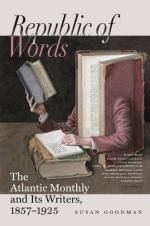In choosing stereoscopic pictures, beware of investing largely in groups. The owner soon gets tired to death of them. Two or three of the most striking among them are worth having, but mostly they detestable,—vulgar repetitions of vulgar models, shamming grace, gentility, and emotion, by the aid of costumes, attitudes, expressions, and accessories worthy only of a Thespian society of candle-snuffers. In buying brides under veils, and such figures, look at the lady’s hands. You will very probably find the young countess is a maid-of-all-work. The presence of a human figure adds greatly to the interest of all architectural views, by giving us a standard of size, and should often decide our choice out of a variety of such pictures. No view pleases the eye which has glaring patches in it,—a perfectly white-looking river, for instance,—or trees and shrubs in full leaf, but looking as if they were covered with snow,—or glaring roads, or frosted-looking stones and pebbles. As for composition in landscape, each person must consult his own taste. All have agreed in admiring many of the Irish views, as those about the Lakes of Killarney, for instance, which are beautiful alike in general effect and in nicety of detail. The glass views on the Rhine, and of the Pyrenees in Spain, are of consummate beauty. As a specimen of the most perfect, in its truth and union of harmony and contrast, the view of the Circus of Gavarni, with the female figure on horseback in the front ground, is not surpassed by any we remember to have seen.
* * * * *
What is to come of the stereoscope and the photograph we are almost afraid to guess, lest we should seem extravagant. But, premising that we are to give a colored stereoscopic mental view of their prospects, we will venture on a few glimpses at a conceivable, if not a possible future.
Form is henceforth divorced from matter. In fact, matter as a visible object is of no great use any longer, except as the mould on which form is shaped. Give us a few negatives of a thing worth seeing, taken from different points of view, and that is all we want of it. Pull it down or burn it up, if you please. We must, perhaps, sacrifice some luxury in the loss of color; but form and light, and shade are the great things, and even color can be added, and perhaps by and by may be got direct from Nature.
There is only one Coliseum or Pantheon; but how many millions of potential negatives have they shed,—representatives of billions of pictures,—since they were erected! Matter in large masses must always be fixed and dear; form is cheap and transportable. We have got the fruit of creation now, and need not trouble ourselves with the core. Every conceivable object of Nature and Art will soon scale off its surface for us. Men will hunt all curious, beautiful, grand objects, as they hunt the cattle in South America, for their skins, and leave the carcasses as of little worth.




